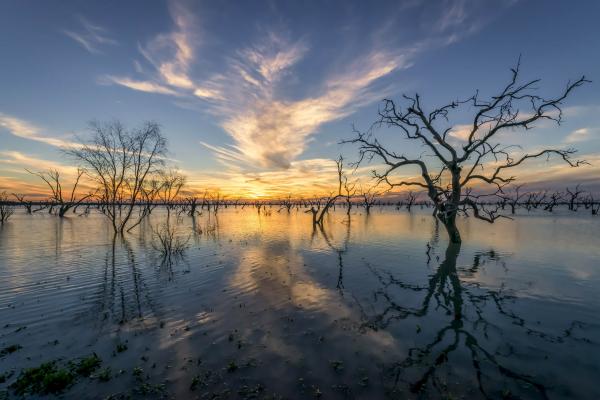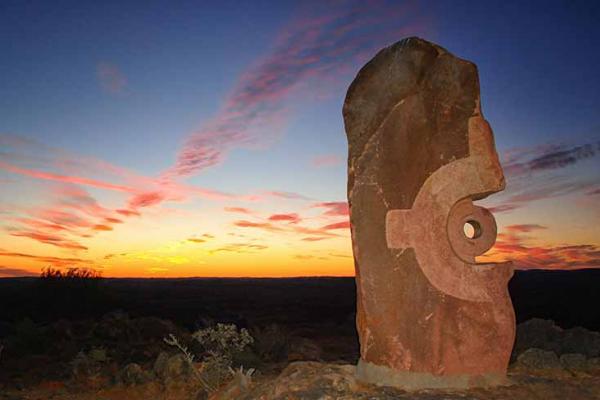BEAUTIFUL LANDSCAPES AND NATIONAL PARKS
Outback New South Wales (NSW) is a haven for nature lovers, not least of all because it boasts such a wide range of extraordinary and diverse national parks. Whether you enjoy bush walking, bird watching, mountain biking, camping or four-wheel driving, you’re guaranteed to find it near Broken Hill.
Before you head out on your own, it’s always a good idea to check with the visitor centre or our local reception team that areas you are planning to visit are open.
RICH ABORIGINAL HERITAGE
The Aboriginal heritage of the outback is extremely palpable and can be felt right across the region. From the mysteries of the Mungo National Park to the long Aboriginal history of Wilcannia, no trip to the outback is complete without immersing yourself in this fascinating history. Learn about the rock art in Mutawintji National Park with Away Tours and glimpse unique indigenous artefacts in Tibooburra, visit the famous Living Desert Reserve in Broken Hill.
KINCHEGA NATIONAL PARK (Two hours drive)
Kinchega National Park is the traditional land of the Paakantji nation, a river people who caught fish by spearing from a canoe or while diving and used nets and fi sh traps made from baskets. Artefacts and special sites in the area date back an incredible 35,000 years.
Meander along the Darling River’s red gum-lined banks, which mark the park’s eastern boundary, or stroll the shores of Lake Menindee, Lake Cawndilla and Lake Emu. It’s a dry landscape that bursts with seasonal wildfl owers after rain. Abundant wildlife – birds, kangaroos, goannas and emus – bring opportunities for photography.
Explore Aboriginal sites and European buildings including Kinchega Woolshed and its adjacent walks. As you explore, you’ll be given a taste of a harsh history in this challenging environment. In the dry or wet, the lakes provide a peaceful place for picnicking and taking in the tranquillity of the natural surrounds. The Darling River Run is accessible by cars, caravans and campers along its meandering path.
Kinchega is just 100km south of Broken Hill, near the township of Menindee.
PAROO-DARLING NATIONAL PARK (Under three hours drive)
The Paroo River wetland system is one of the most important in NSW and comprises the only unregulated river in the Murray-Darling catchment. Paroo-Darling National Park embraces these wetlands. You’ll need to take time to explore to experience the scale and diversity of natural habitats such as Peery Lake. In seasons of plenty, walk around the lake edge or launch a canoe and marvel at the birdlife – 60,000 birds were recorded in the last survey. During seasons of dry the lake reveals its secrets of stone and sandy areas together with intriguing landscape. The west end of the park is about 20km northeast of White Cliffs and west of Wilcannia, within the country of the Paakantji people. Significant sites reveal a great deal about their way of life over the last 10,000 years. There are scenic picnic areas on the Darling River at the Coach and Horses campground 40km north of Wilcannia on the east side of the river. Be sure to bring your fishing rod to this popular fishing spot and keep your camera or iPhone ready to snap the local wldlife!
MUTAWINTJI NATIONAL PARK (Under three and a half hours drive)
The fiery red ranges of Bynguano colour the magnificent Mutawintji (“place of green grass and waterholes”) National Park. Meander through this sacred area, keeping a keen eye out for native wildlife including majestic wedge-tailed eagles, peregrine falcons and endangered yellow-footed rock wallabies, Australia’s most brightly coloured mammal. Deep gorges lead to tranquil rock pools and river red gum lined creek beds. Walks in this park are leisurely meanders of discovery through the traditional home of the Malyankapa and Paakantji people. Mutawintji, just north of Broken Hill, has been a signifi cant meeting place for thousands of years; a place of initiations, rainmaking and other ceremonies. Explore Mutawintji Historic Site, which sits within Mutawintji National Park, on a guided tour. It contains some of NSW’s finest Aboriginal paintings, stencils and engravings in caves and on rock formations.
MT GRENFELL HISTORIC SITE (Less than six hours drive)
Mount Grenfell Historic Site’s quiet and remote location attracts adventurous visitors … rewarded with an amazing collection of Aboriginal art reflecting the long history and culture of Ngiyampaa Country. Among the depictions are dancing figures, kangaroo, emu, and lizards – images from many different time periods by many different artists. The tranquillity of the site is ideal to fully appreciate this unique piece of Australia’s heritage, and speculate on the stories that inspired the artwork. There is a picnic area near the entrance, a place to rest, relax and recharge before taking the short walk to the rock art, or tackling the longer Ngiyampaa walk which features panoramic views from the ridge.
Access Mount Grenfell by driving west from Cobar along the Barrier Highway for 40km, and right at the Mount Grenfell Historic Site sign for about 30km along the dry weather road.
MUNGO NATIONAL PARK (six hours drive)
This extraordinary place is of great signifi cance to the Ngiyampaa, Mutthi Mutthi and southern Paakantji people, a connection that reaches back more than 40,000 years. Mungo National Park has the oldest recorded cremation in the world. A famous feature of the park is the dramatically sculpted clay and sand formations known as the Walls of China that stretch for about 30km. Evidence of early human habitation is everywhere in and around this moonscape; ancient fi replaces, stone tools and other artefacts. These contrast with unfamiliar fossils of preserved mega-fauna and prehistoric plant life. Long after the mega fauna came mega flocks of sheep on historic Gol Gol Station, now preserved as part of the park.
The Walls walk is accessible by guided tours, while the boardwalk is available to all, along with the loop drive, Zanci Woolshed and pastoral loop drive and other walks to enjoy at leisure.
A thriving kangaroo and emu population also make Mungo the perfect place to see Australia’s coat of arms up close. There is the amazing sight and sound of hundreds of pink cockatoos and diverse bird species taking turns drinking from ground tanks. Standing out from the crowd is the Mallee ring-neck parrot with its vivid green and gold plumage.
Adjacent to Mungo Visitor Centre is Mungo Woolshed. Built in 1869, it stands a striking reminder of the pastoral history of this dramatic landscape. Step inside the shady cool and marvel at the ingenious drop-log construction made from local cypress pine. At its peak, this shed was a hive of activity, with 18 men hand shearing over 50,000 sheep. Erosion caused by sheep, rabbits and tree felling not only reduced the capacity for farming, it revealed the long-held secrets of the ancient lakebed. Mungo lies at the heart of the Willandra Lakes World Heritage Area, added to the World Heritage list in 1981.
YANGA NATIONAL PARK (six hours drive)
A fi sherman’s paradise, Yanga National Park embraces magnificent river frontage, wetlands, lakes and breeding grounds for waterbirds. It forms part of the Lower Murrumbidgee Floodplain, with more than 22,000ha of river red gum forest, black box-nitre goosefoot swamp, belah rosewood woodlands, and native grassland and saltbush plains. For more than 160 years, Yanga was a working pastoral, cropping and irrigation property. Today, the Yanga Homestead and Woolshed, about 5km south-west of Balranald on the Windomal Road, are restored and ready to explore or tour. The woolshed has an interpretive display describing historical aspects of Yanga Station, the riverboat trade, the pastoral life in the western Riverina, and the evolution of the Lower Murrumbidgee Floodplain. Tucked along the banks of the river are campgrounds, bushwalks and plenty of spots to cast a line or launch a canoe . You’ll need time, time to unearth a diverse and ancient history in an area once peopled by Aboriginal families, with scar trees, ovens, middens and other artefacts scattered throughout the park. Explorers and pioneers, shearers and rabbit trappers have also left their mark. Access to Yanga is 8km south-east of Balranald off the Sturt Highway.
GUNDABOOKA NATIONAL PARK (six hours drive)
The mysterious Mount Gundabooka stands sentry over Gundabooka National Park and State Conservation Area, a vast landscape rich in Aboriginal and European heritage stretching from the banks of the Darling River across the plains. Mount Gundabooka seems to accompany you as you explore the surrounding woodlands, floodplains and sand hills, significant to the local Ngemba and Baakandji people.
You can gain a sense of the enduring culture of the Ngemba people on the Mulgowan (Yapa) Aboriginal Art Site walking track. Arriving at the enormous rock overhang, you’ll discover unique Aboriginal rock paintings that depict animal motifs, dancers, hand stencils and hunting tools. The park is made up of old sheep stations – Ben Lomond, Belah and Mulgowan, with great opportunities to explore old homesteads, quarters, fences, tanks and shearing sheds. The pastoral station Yanda is now the State Conservation Area, gazetted in 2005.
WILLANDRA NATIONAL PARK (Less than six and half hours drive)
Once famous for wool productions, Willandra National Park gives insight into the region’s pastoral heritage. The old homestead and shearing shed precincts are fascinating to explore. The park’s natural attractions are just as compelling – it’s no wonder this peaceful and secluded place is favoured by photographers and artists.
Vast, semi-arid riverine plains incorporate wetlands, grasslands, and black box-lined creeks. These support an abundance of wildfl owers, kangaroos and emus, waterbirds, reptiles and frogs. Activities include the Nilla Yannagalang Billana walking track – the name means “walking alone together” and it will seem that your only company is nature as you meander alongside the Willandra Creek. There are picnic and barbecue areas, plus opportunities for cycling, fi shing, seasonal canoeing and nature study.
The park is about an hour from Hillston via the Ivanhoe-Mossgiel Road and Whealbah-Trida Road.
STURT NATIONAL PARK (Six and a half hours drive)
Rolling red sand dunes, seasonal wetlands, woodlands and grass plains combine in one of the largest, most distinctive national parks in NSW. Sturt National Park is steeped in Outback beauty, protecting an enormous arid landscape of space and solitude – from the rolling red sand dunes of the Strezlecki desert to the fl at-topped mesas around Tibooburra. Tibooburra means “heaps of rocks” in the local Aboriginal language, acknowledging the 450 million year old granite tors that surround the town and line the road on the way to the park. These contrast with the red sand of the desert on the western side of the park and with the ‘jump ups’ that rise from the plains in the central part. Walks and drives within the park let you to stop and soak up the beautiful surroundings.
For more up close views of the landscape, try the short loop walks at Fort Grey or Dead Horse Gully. Climb to the summit of Mount Wood for stunning views over the park. Or walk to Sturt’s Tree across Lake Pinnaroo (in the dry seasons) for a sense of what it must have been like for the first European explorers visiting Wangkumara, Malyankapa and Wadikali country.
Named after the famous explorer, Charles Sturt, and a place of Aboriginal occupation dating back more than 20,000 years, Sturt National Park is located in the north-west corner of the state near Tibooburra. It is bounded to the north and west by the ‘wild dog fence’ – the longest fence in the world stretching 5614 kilometres. Accessible by caravans and camper trailers there are good facilities to enjoy a barbecue or picnic amongst the park’s resident kangaroos and abundant birdlife.






